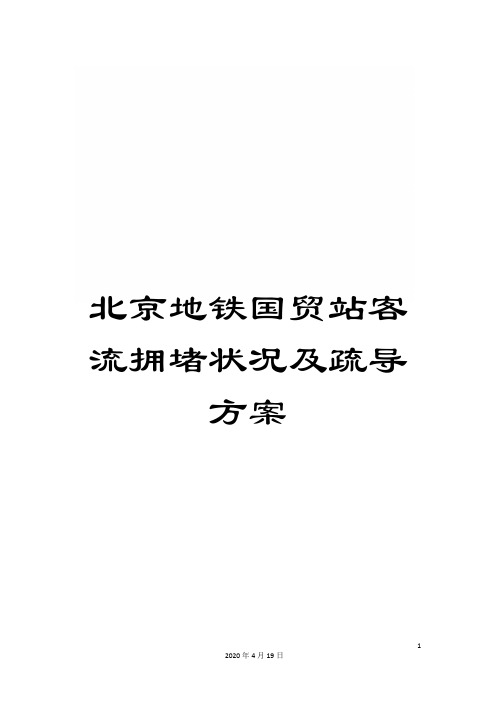北京市交通拥堵特征分析
- 格式:docx
- 大小:158.69 KB
- 文档页数:63

北京市交通拥堵宏观评价指标体系开发及其应用郭继孚1,刘梦涵2,于雷2,3 ,关积珍4,郭淑霞2,张雪莲2(1.北京交通发展研究中心中国北京 10055; 2.北京交通大学交通运输学院中国北京100044;3. 德克萨斯南方大学,美国休斯敦 77004; 4.北京四通智能交通系统集成有限公司中国北京100081)摘要:交通拥堵宏观评价用于总体描述全市路网或者特定区域的交通拥堵现象及其潜在规律。
现有的研究方法能够从不同侧面反映交通拥堵现象,但不能从整体上多角度反映路网的拥堵状态,也不能够对整个路网实时运行状态进行动态跟踪。
本论文通过分析北京市道路网交通拥堵所呈现出的多样化特征,设计和开发了一套符合北京市特点的宏观交通拥堵评价指标体系,全面、系统、科学地量化北京市总体交通拥堵程度及时空演变规律。
通过采集持续2006年3月份持续一周的浮动车数据,对北京市五环内实际的道路网拥堵指标进行计算和分析,初步得到了北京市道路网交通拥堵的潜在规律,该研究结论为把握现阶段的拥堵水平,后续跟踪拥堵的发展态势奠定了良好的基础。
关键词:交通拥堵;宏观评价;时空分布Development and Applications of Macroscopic Measurement of TrafficCongestion in BeijingJifu Guo1, Menghan Liu 2,Lei Yu 2,3 , Jizhen Guan4, Shuxia Guo2,Xuelian Zhang2(1. Beijing Transportation Research Center, Beijing 100055, China; 2. School of Traffic and Transportation, Beijing Jiaotong University, Beijing 100044, China; 3. Texas Southern University, Houston, TX 77004,U.S.A.; 4. Beijing Stone Intelligent Transportation System Ingegration Co.,LTD, Beijing 100081, China)Abstract: The macroscopic measurement of traffic congestion is used to describe the phenomena and potential rules of congestion for the entire network or specific areas. The existing methods can measure traffic congestion from several single aspects. However, they can not demonstrate the full-spectrum congestion condition of the entire network, and also can not capture the dynamic traffic characteristics. This paper is intended to develop the macroscopic evaluation indices for traffic congestion based on analyzing the diverse characteristics of traffic congestion in Beijing. The proposed method can measure the extent and spatial-temporal distribution of congestion for Beijing comprehensively. In the case study, traffic congestion indices within the Fifth Ring-Road are evaluated using the floating car data collected in one week of March, 2006 in Beijing. This study investigates preliminarily the potential rules of traffic congestion in Beijing, which will contribute to grasp the current situation and also the future trend of congestion.Key words: Traffic Congestion; Macroscopic Measurement; Spatio-temporal Distribution1引言交通拥堵源于交通需求水平大于交通供给能力而引起的车辆聚集现象。

城市交通拥堵指数分析报告一、引言城市交通拥堵是当今城市化进程中的普遍问题。
本报告旨在通过分析城市交通拥堵指数,探讨交通拥堵的原因和对策,为改善城市交通状况提供参考。
二、城市交通拥堵指数的计算方法城市交通拥堵指数是衡量城市交通拥堵程度的重要指标。
它通常由交通量、路段速度、路网密度等指标综合计算得出。
其中,交通量可通过道路监控设备或移动App采集、路段速度可通过车载导航数据获取、路网密度可通过道路地理信息系统的分析得出。
三、城市交通拥堵指数的实证分析1. 城市交通拥堵指数的选取在实证分析中,我们选取了十座不同规模和特征的城市作为研究对象,包括北京、上海、广州、深圳、成都、武汉、西安、重庆、杭州和南京。
2. 城市交通拥堵指数的计算结果根据数据分析结果显示,北京、上海和广州是交通拥堵最严重的城市,其交通拥堵指数位列前三。
而成都、武汉和南京等城市的交通拥堵指数相对较低。
3. 城市交通拥堵指数的原因分析城市交通拥堵的原因多种多样,主要包括人口与车辆增长、道路规划不合理、公共交通不完善等。
以北京为例,人口密集和汽车保有量的快速增长导致了交通压力的加剧,同时道路建设滞后和公共交通网络短板也是导致交通拥堵的重要原因。
四、改善城市交通拥堵的对策1. 发展公共交通系统加大对公共交通系统建设的投入,优化线路布局,提高服务水平,鼓励市民使用公共交通工具,减少私家车辆出行。
2. 完善道路建设规划合理规划道路建设,提高道路通行能力,同时加强路网改造和交通信号灯的优化,优化交通流动性。
3. 推广智能交通系统借助先进的智能交通技术,如交通信号优化控制系统和智能导航系统,提高交通流通效率。
4. 实施交通拥堵收费通过交通拥堵收费来引导市民选择合理的出行方式,减少私家车辆数量,缓解交通压力。
五、结论本报告通过分析城市交通拥堵指数,提出了改善城市交通拥堵的对策。
然而,解决城市交通拥堵问题需要全社会的共同努力,各级政府、企事业单位和市民个体都应积极参与,并采取有力措施,共同推动交通拥堵问题的缓解和解决。

城市交通拥堵状况的数据统计分析首先,进行城市交通拥堵数据的收集工作是分析的第一步。
可以利用GPS定位以及交通信号系统,收集车辆在不同时间段内的行驶速度、拥堵程度以及车流量等数据。
同时,还可以利用高架桥、隧道等交通监控设施,收集交通事故数据和交通瓶颈点等信息。
通过全面、准确地收集数据,可以为后续的分析提供可靠的基础。
在数据统计分析的过程中,可以通过时间序列方法对历史数据进行分析。
时间序列分析可以揭示交通拥堵的发展趋势,帮助决策者了解交通拥堵问题的严重程度以及可能出现的未来发展趋势。
通过对历史数据的分析,可以判断交通拥堵问题的季节性、周末效应以及每天的高峰时段等规律。
这些规律性数据将有助于制定针对性的解决方案。
此外,对交通拥堵数据进行空间分析也是必不可少的。
可以利用地理信息系统(GIS)对城市中不同区域的交通拥堵状况进行可视化展示。
通过空间分析,可以发现城市中的交通瓶颈点、热点区域以及交通拥堵的规律性分布。
这些信息有助于城市规划者、交通管理部门以及居民更好地了解交通拥堵问题的空间分布特征,从而为解决问题提供更有针对性的策略。
最后,通过数据统计分析,可以识别出交通拥堵的主要原因。
可以对城市道路网的结构进行分析,确定交通拥堵的瓶颈区域以及交通流的拥挤点。
同时,还可以通过数据分析来了解驾驶行为和出行模式对交通拥堵的影响。
通过这些分析,可以找到导致交通拥堵的关键因素,为制定相应的交通改善措施提供依据。
综上所述,城市交通拥堵的数据统计分析对于解决交通拥堵问题具有重要意义。
通过数据收集和分析,可以发现交通拥堵的规律和原因,为解决问题提供依据。
此外,还可以通过时间序列和空间分析等方法,揭示交通拥堵的发展趋势和空间分布特征。
通过科学的数据统计分析,帮助决策者制定有效的交通管理策略,促进城市交通的有序发展。

北京市交通拥堵指数的计算北京市交通拥堵指数的计算北京市作为中国的首都,人口密度高、交通流量大,交通拥堵问题一直是困扰市民的一个难题。
为了更好地了解北京市交通拥堵状况,有必要对交通拥堵指数进行计算。
下面就来介绍一下北京市交通拥堵指数的计算方法。
1. 数据来源北京市交通拥堵指数的计算需要依赖于大量的数据。
这些数据包括:交通流量、交通速度、道路容量、交通事故等。
这些数据可以通过交通监测设备、交通管理部门以及交通事故报告等途径获取。
2. 计算方法北京市交通拥堵指数的计算方法一般采用交通流量和交通速度的比值。
具体计算方法如下:交通拥堵指数 = 交通流量 / 交通速度其中,交通流量指的是单位时间内通过某一道路的车辆数量,单位为辆/小时;交通速度指的是车辆在道路上行驶的速度,单位为公里/小时。
3. 影响因素北京市交通拥堵指数的计算受到多种因素的影响,主要包括:(1) 车辆密度:车辆密度越大,交通拥堵指数越高;(2) 道路容量:道路容量越大,交通拥堵指数越低;(3) 交通事故:交通事故会导致道路封闭或者交通管制,从而增加交通拥堵指数;(4) 天气因素:恶劣的天气条件会降低车辆行驶的速度,从而增加交通拥堵指数。
4. 应用场景北京市交通拥堵指数的计算可以应用于多个场景,主要包括:(1) 交通管理:通过交通拥堵指数的计算,交通管理部门可以了解道路拥堵情况,及时采取措施疏导交通,缓解交通拥堵;(2) 市民出行:市民可以通过查询交通拥堵指数,选择较少拥堵的道路,避免浪费时间在交通拥堵中;(3) 城市规划:交通拥堵指数的计算可以为城市规划提供数据支持,指导城市道路建设和交通管理,提高城市交通运行效率。
综上所述,北京市交通拥堵指数的计算可以为交通管理、市民出行和城市规划等方面提供重要数据支持,为缓解交通拥堵问题提供帮助。

城市交通拥堵的数据分析与对策随着城市化进程的加快以及私家车拥有量的增加,城市交通拥堵问题日益严重。
那么,如何进行数据分析,并采取相应的对策来解决城市交通拥堵问题呢?一、数据分析1. 交通拥堵程度分析针对不同城市,通过交通拥堵指数、交通速度变化、堵车里程等数据指标,可以综合评估城市的交通拥堵程度。
比如,根据交通拥堵指数,我们可以将城市的拥堵程度分为轻度、中度、重度和严重四个级别,从而确定问题的严重程度。
2. 交通流量分析通过交通流量统计数据,我们可以分析城市主要交通干道的运行情况,了解高峰时段的交通流量分布,从而为拥堵点的选取和交通优化方案的制定提供数据支持。
3. 高峰出行时段分析结合GPS定位数据和移动网络数据,可以分析高峰出行时段的具体特征,了解人们的出行规律和出行需求,并根据这些数据制定合理的交通管理措施。
4. 交通事故数据分析通过分析交通事故数据,可以寻找交通事故高发区域,进而规划改善交通路网,减少事故发生,提高交通效率。
二、对策建议1. 建设公共交通系统加大对公共交通系统的投资力度,提高公共交通的覆盖率和运营效率,鼓励居民选择公共交通出行,减少私家车的使用,从而减缓交通拥堵问题。
2. 建立智能交通管理系统运用现代信息技术手段,建立起智能交通管理系统,包括交通信号灯的优化配时、智能路线导航和交通流量监测等功能,提高道路通行效率,减少拥堵。
3. 加强交通规划和道路建设根据交通数据分析结果,科学规划城市道路网,合理布局道路系统,加强道路建设和扩容,缓解瓶颈区域的交通压力,提高交通通行能力。
4. 推广共享出行模式鼓励和支持共享出行模式的发展,比如共享单车、共享汽车等,减少私家车的使用频率,提高城市交通资源的利用率。
5. 培养绿色出行意识积极宣传环保和绿色出行的理念,引导市民步行、骑行、乘坐公共交通等低碳出行方式,减少尾气排放,改善城市空气质量。
6. 引导错峰出行鼓励企事业单位制定灵活的工作制度,推动员工在相对非性交通高峰期出行,减少高峰时段的交通压力。

北京地铁国贸站客流拥堵状况及疏导方案北京地铁国贸车站的组织优化小组:x x x x x x x指导教师:x x x(北京城市学院北京 100086)作品内容简介文以缓解北京市轨道交通换乘站拥堵压力为目标,对地铁国贸站进行了实地调研,找到问题,提出优化方案。
本文选取北京地铁国贸站作为主要研究对象,着眼于如何提高并充分发挥城市轨道交通运营组织的运输效能、营造一个快捷、安全、舒适的乘车环境。
经多次实地调查与研究,提出几种站台疏导方案,从而更好的解决站台的客流拥堵,提高地铁的运营组织效能。
关键字:北京地铁;客流拥堵,轨道交通1.引言在中国城市化过程中,城市结构及区域经济布局的变化主要体现在空间的更充分利用和平面的不均衡扩展上,同时流动人口增长迅速,居民出行更为频繁,城市交通日趋紧张。
北京作为新兴经济大国的首都,正在被日益加剧的交通拥堵问题所困扰。
随着北京市人口的不断增加,城市发展的速度远远超过了基础建设的承受能力。
越来越多的人选择方便快捷的地铁出行方式,为此,北京市政府投入大量资金,力求建设全国最大的轨道交通网。
地铁线路以发展到17条运营线路,270座运营车站,456千米运营里程,日载客峰值1105.52万人次。
是当前世界上规模最大,运营里程世界第二的城市地铁系统,亦是中国大陆最繁忙的城市轨道交通系统。
北京市人口的持续增加,已使北京市地铁的多条线路的运力基本达到极限。
提高了列车运送能力,显然还不足以充分发挥城市轨道交通运营组织的运输效能,解决站台的客流拥堵正是提高地铁运输效能的关键。
2.正文部分2.1 车站介绍国贸站是北京地铁10号线与1号线的换乘站,位于东三环中路与建国门外大街的交叉路口以北。
车站主体与东三环中路走向一致,该站是在国贸立交主桥辅桥的桥桩群的缝隙中争取空间建成的,采用暗挖法施工。
国贸站所在的地铁1号线日均客流近140万人次,10号线日均客流近200万人次。
当前,地铁国贸站客流换乘量已接近饱和。
北京市交通拥堵指数的计算北京作为中国的首都,交通拥堵一直是城市面临的严重问题之一。
为了更好地评估和监测交通拥堵的情况,北京市交通部门引入了交通拥堵指数的计算方法。
交通拥堵指数是指用来衡量交通状况的一种指标,通常通过对交通速度、车流量、拥堵时间等数据进行统计分析来计算得出。
在北京,交通拥堵指数的计算涉及到多个方面的数据和参数。
交通速度是计算交通拥堵指数的重要参数之一。
在北京,交通部门会通过交通监控设备实时监测各个道路的车辆行驶速度,根据车辆的平均速度来评估交通的畅通程度。
车辆速度越慢,交通拥堵程度就越严重,交通拥堵指数也会相应增加。
车流量也是影响交通拥堵指数的关键因素之一。
北京作为人口密集的大城市,车辆数量庞大,尤其是在上下班高峰期,交通拥堵现象普遍存在。
交通部门会通过交通摄像头和车辆识别系统统计各个道路的车流量,根据车流量的密度来确定交通拥堵指数的大小。
除了交通速度和车流量,拥堵时间也是计算交通拥堵指数的重要考量因素。
在北京,交通部门会对各个路段的拥堵时间进行监测和记录,包括早晚高峰时段的拥堵情况以及节假日等特殊情况下的交通状况。
拥堵时间的长短也会直接影响交通拥堵指数的高低。
综合考虑交通速度、车流量和拥堵时间等多个因素,北京市交通部门可以计算出每个路段或者整个城市的交通拥堵指数。
交通拥堵指数的大小可以帮助政府部门和交通管理机构更好地制定交通管理政策,优化道路规划,缓解交通拥堵问题,提高城市的交通效率和居民的出行体验。
总的来说,北京市交通拥堵指数的计算是一个复杂而又重要的工作。
通过科学的数据分析和计算,可以更准确地评估交通拥堵的程度,为城市交通管理提供有益的参考依据,帮助改善城市交通状况,提升居民生活质量。
希望未来北京的交通拥堵问题能够得到有效解决,让城市的交通更加畅通顺畅。
摘要摘要伴随着人口的增长,经济的高速发展以及城市化水平的提高,城市机动车保有量急剧增长,城市交通拥堵状况也随之日益严峻。
交通拥堵给居民的生产和生活带来了诸多不便,严重制约城市的可持续发展。
拥堵问题始终是诸多学者和专家关注的焦点。
而交通拥堵问题主要由交通供给和交通需求不均衡导致的。
北京现阶段交通需求的特点:一是出行需求总量巨大超过了现阶段的道路供给水平;二是出行方式结构不合理,私家车占比过高,公共交通占比有待提高。
本文以北京市为实证研究对象,阐述北京的交通拥堵特征,为北京交通拥堵治理和城市交通规划提出建议,也为其它特大城市乃至全国的交通规划提供参考和借鉴。
本文以交通供需理论、城市交通发展理论、需求管理理论作为理论基础,在总结相关理论和文献的基础上,首先对交通需求特征、交通供给特征进行分析,从宏观层面介绍北京市交通供需现状。
然后依据抓取的数据对北京市道路拥堵特征进行了定性分析和描述性统计分析,分析了北京市交通拥堵的时间特征和拥堵的空间特征以及其他一些拥堵特征。
最后采用多元对数回归模型,以线上抓取和实地调查的数据为基础,对道路拥堵与车辆数的关系以及道路交通拥堵的影响因素进行模型实证分析。
通过实证分析得出如下结论:一是在道路很通畅的情况下,车辆数的增加对拥堵几乎没有影响;之后伴随着车辆数的增加,拥堵呈现边际递增;在达到一定的车辆数之后,拥堵随着车辆数的增加呈现边际递减,并逐渐达到饱和。
二是道路沿线是否有地铁对道路拥堵程度的影响不显著,公交站密度和公交专用道加重了高峰期的道路拥堵状况,人均GDP和常住人口对道路影响是显著的,这部分决定了出行需求总量。
最后针对实证结论,本文提出应对交通拥堵的关键在于控制交通需求总量,优化出行结构,减少小汽车出行数量和比例,为了削减道路上行驶的车辆数,可以考虑征收拥堵费,利用经济杠杆,从总体上消减小汽车出行数量,限制特定时间特定路段的交通流量,调节交通流量的时空分布,达到缓解交通拥堵的作用。
征收拥堵费的同时,需要相应的配套保障措施,提升公共交通的服务水平是必须的。
关键词:交通拥堵拥堵特征影响因素治理对策ABSTRACTWith the growth of population, the rapid development of economy and the advancement of urbanization, the quantity of motor vehicles is increasing rapidly, and the traffic congestion is becoming more and more serious. Traffic congestion has brought a lot of inconvenience to urban residents' work and life, which has seriously restricted the sustainable development of the city. Traffic congestion has been the focus of attention of many scholars and experts. Urban traffic congestion is mainly caused by the imbalance of traffic supply and traffic demand. The characteristics of traffic demand in Beijing : firstly, huge amount of travel demand exceeds supply road level ; secondly, residents travel structure is not reasonable, the proportion of car trip is too high and the proportion of public transport needs to be improved. This paper takes Beijing city as the research object, describes the characteristics of traffic congestion in Beijing City, put forward the proposal for the Beijing city traffic congestion management and traffic planning and provide reference for other large city and even the country's transportation planning-center.Based on the theory of traffic supply and demand, urban traffic development theory, demand management theory. based on summarizing the relevant theory and literature. Firstly, this article analyzes characteristics of traffic demand and traffic supply and introduces the status quo of traffic supply and demand in Beijing city from the macro level. Secondly,this article carries on the qualitative analysis and descriptive statistical analysis of the road traffic congestion in Beijing City; also the time characteristics of traffic congestion and the spatial characteristics of congestion in Beijing are analyzed. Thirdly, based on the data of the online grab and field survey, this article uses the polynomial regression model and the multiple regression model to analyze the relationship between the traffic congestion and the number of vehicles and the factors influencing the traffic congestion in Beijing city.Through the analysis of the sample data, this article drawn the following conclusions: Firstly, in the frist stage, the increase of the number of vehicles on the road is very smooth, it has no effect on the number of vehicles; in the second stage, with the increase of the number of vehicles, the traffic congestion is increasing; in the third stage, after reaching a certain number of vehicles, the traffic congestion is decreasing and gradually reach saturation. Secondly whether there is a subway line along the road has no significant effect on road congestion degree; bus station and bus lane densityincreased road congestion during the peak period; per capita GDP and the resident population determines the total travel demand. Finally, according to the empirical conclusion, control traffic demand is the key to deal with traffic congestion. optimizing travel structure, reduce the number and proportion of car travel are also needed. In order to cut the number of vehicles traveling on the road, we can consider the use of economic levers-congestion charge.Regulate the temporal and spatial distribution of traffic flow to ease traffic congestion effect. Inorder to carry on congestion charges, we must enhance the level of public transport services at the same time.KEYWORDS:traffic congestion, congestion characteristics, influence factor, countermeasure.目录摘要 (I)ABSTRACT (II)1引言 (1)1.1研究背景及意义 (1)1.1.1 研究背景 (1)1.1.2 研究意义 (2)1.2研究思路及论文结构 (2)1.2.1 主要研究思路 (2)1.2.2 论文结构 (3)2相关理论及文献综述 (4)2.1相关理论 (4)2.1.1 交通供需理论 (4)2.1.2 城市交通可持续发展理论 (6)2.1.3 交通需求管理理论 (7)2.1.4 交通拥堵相关概念 (8)2.2文献综述 (11)2.2.1 国外文献综述 (11)2.2.2 国内文献综述 (13)3特大城市交通拥堵特征 (15)3.1交通供需特征 (15)3.1.1 交通需求特征 (15)3.1.2 交通供给特征 (16)3.2交通拥堵特征 (17)4北京市交通拥堵特征现状分析 (18)4.1北京市交通的供需特征 (18)4.1.1 北京市交通需求现状 (18)4.1.2 北京市交通供给现状 (21)4.2北京市交通拥堵特征 (23)4.2.1 数据介绍 (23)4.2.2 时间分布特征 (25)4.2.3 空间分布特征 (30)4.2.4 其他拥堵特征 (32)5北京市交通拥堵特征实证分析 (35)5.1道路拥堵与车辆数关系 (35)5.1.1 数据获取 (35)5.1.2 模型设定 (36)5.1.3 数据实证分析 (37)5.1.4 实证结果 (38)5.2路段拥堵影响因素分析 (38)5.2.1 指标选取 (38)5.2.2 模型建立 (39)5.2.3 数据实证分析 (39)5.2.4 实证结果 (42)6北京市交通拥堵问题的解决措施 (44)6.1现有治堵措施及效果总结 (44)6.2交通拥堵的解决措施 (45)6.2.1 交通需求管理 (45)6.2.2 控制小汽车出行的必要性 (46)6.2.3 控制小汽车出行的措施 (47)7结论与建议 (49)7.1研究结论 (49)7.2政策建议 (50)参考文献 (53)1引言1.1 研究背景及意义1.1.1 研究背景伴随着人口的增长,经济的高速发展以及城市化进程的推进,在我国许多特大型城市出现了严重的交通拥挤及堵塞现象。